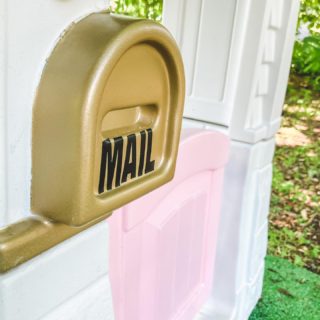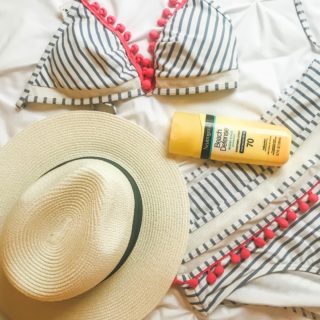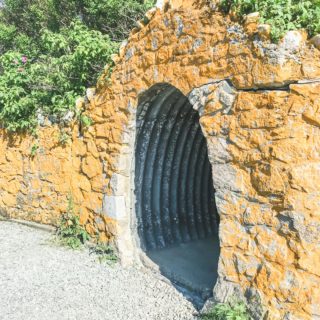Happy Halloween! It’s the perfect time to talk about scary, ugly ceramic bathroom tile! When we moved into our new house (see post on it here!) I couldn’t wait to get started on “projects.” I took stock of what I had to work with and though our house had great high ceilings, beautiful shiny wood floors, and large windows that let in a lot of natural light, the kitchen and bathroom were in particular need of updating. Luckily, both can be updated on a small budget if you know how!
Painting Old Ceramic Bathroom Tile: Planning Ahead
- Once you start the process of painting the ceramic bathroom tile, you will not be able to get it wet for 3 days. Since we only have one bathroom, and our tile was actually above the shower, I had to plan ahead so that our 3 days were over the weekend where schedules (and showers!) were more flexible.
- Check the weather report for the days you will paint and leave the paint to dry. You will need to have the windows open so make sure it will be warm enough to do so.
- Gather materials.
Painting Old Ceramic Bathroom Tile: Materials
*The following links are affiliate links and may result in a commission for More to Mrs. E. See here for my whole affiliate disclaimer.
LimeAway (I recommend the spray version after using the non-spray version myself)
Abrasive Pad
Orbital Sander and at least five 100 grit sanding disks
Microfiber cloth
Household fan (for air circulation)
Painter’s Tape
4 inch roller and roller cover (others have used foam rollers. This roller kit is a good deal.)
4 inch paint tray
Paint brush or here
Bucket to mix paint
Wooden Paint Stick to mix
Painting Old Ceramic Bathroom Tile:
Day 1 – Thursday
1. If you have caulk surrounding your tile, remove it. The paint will not stick to caulk. The caulk that was present around my tile was rock hard and paintable so I skipped this step.
2. If possible, remove the toilet tank. (Here is a great article for how to do this) My husband and I attempted to do this, to no avail. The screws were simply too rusted into place on the bottom of the tank. We didn’t want to end up having to replace the toilet too, so just left it in place and painted behind it (not recommended).
TIP: If you do this, you will still be able to use the toilet if you have a bucket handy, filled with water that you can use to cause the toilet to flush after being used. You can either fill the tub to make filling the bucket easier or have a bowl that will fit under your bathroom faucet that you refill each time after using the toilet.
3. Remove mildew by scrubbing with bleach and water.
4. Scrub the tiles with Comet. Then, wipe the tiles down with a clean, wet sponge to remove any residue. Let the tile dry thoroughly! (I let it dry overnight)
Day 2 – Friday
Morning
1. Clean the surface of the tiles with LimeAway and an abrasive pad. Rinse with water! Repeat if necessary.
2. Sand with 100 grit synthetic sanding disks and an orbital sander. Wipe away any dust with a microfiber cloth. Rinse away any residue. Allow to dry.
There are different recommendations here. Some say you need to sand away the shine on the tile. Others say you just have to scuff it up so the paint will stick. After trying two different grits of sanding disks, all my sanding did was make the tile very smooth and shiny. I decided to try to paint and see what happened. Though my tile was not scuffed up by the sanding (and therefore didn’t need rinsing), the paint stuck well. I will update this post later if I notice any paint peeling away from the tile.
Afternoon
2. Now it’s time to paint! Mix the paint according to the instructions. This includes mixing the paint and activator together in a separate container before pouring it into the paint tray. I recommend mixing only half at a time so a smaller bucket would work to mix the paint. I used a paint bucket that I’ve had from previous projects.
Pour the paint into your paint tray. Use your brush to thickly apply the paint close to your tape and in corners. Then, use the roller to paint most of the surfaces, rolling over your brush strokes to even out the brush lines. Be careful! Don’t get too close to the tape in case you get the paint on the wall or floors.
- The more paint you have on the roller, the more it tends to slip on the tiles. I eventually got into a groove where I would roll the roller in paint just enough to give it coverage. It made the roller grip the tiles better and gave it a more even coat.
- Once you start using the roller you will want to keep going until you get to the end. Once on the tile, the epoxy levels out and dries down pretty quickly, so keep going! That way areas painted first don’t dry down too much before you come back and add the next section.
- The epoxy paint is intense!! Every 10 minutes or so, walk to a room nearby and take a deep breath of fresh air!
Very carefully remove the painter’s tape before it has had a chance to dry. Epoxy paint is tough and you don’t want it sticking the blue tape to the tile and leaving behind blue chunks every so often along the edge of the tile.
DIY Ceramic Tile Paint Transformation
Though it is a lot of work, in the end it is totally worth it! Here is the final look after the paint!
Next step? Paint the wall and the baseboard heater (which means that ugly wallpaper border has GOT to go!)! Stay tuned for more ugly bathroom transformations!
In the meantime, check out how to make a necklace holder out of an old frame or bathroom storage out of old Bath and Body Works Candle jars! Make sure to follow me on Facebook so you’ll be notified of the next DIY post!
Have you ever painted old ceramic tile? Ever thought about it? Let me know in the comments below!










 Loading...
Loading...



















Leave a Reply